Plastic ducts (cable channels), how to fix the cable channel
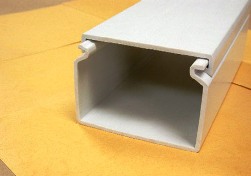 When it becomes necessary to install and install external wiring, preference is most often given to the cable channel. It is understandable: the cable channel complies with fire and electrical safety standards, and in addition, it just looks more advantageous in comparison with, for example, wiring in a corrugated pipe or, especially, open wiring.
When it becomes necessary to install and install external wiring, preference is most often given to the cable channel. It is understandable: the cable channel complies with fire and electrical safety standards, and in addition, it just looks more advantageous in comparison with, for example, wiring in a corrugated pipe or, especially, open wiring.
However, the installation and closure of cable channels (ducts) is truly the highest aerobatics of installing office and home electrical wiring. The variety of sizes, designs and properties of cable channels is so wide that there is simply no question of any uniform rules that uniquely establish the technology for installing plastic boxes. Therefore, those who are going to deal with the cable channel for the first time can be given only some tips that are purely recommendatory in nature ...
 Very often, electricians have to connect the electrical installation to an existing line, passing by in relative proximity. In other words, it is necessary to create a branch of the wires.
Very often, electricians have to connect the electrical installation to an existing line, passing by in relative proximity. In other words, it is necessary to create a branch of the wires.
An example is the connection of a private house to a 0.4 kV overhead line or the connection of an apartment electrical switchboard to access electric risers. In both of these cases, the line passes, possibly very close by - here they are, the coveted 220 or 380 volts with the necessary reserve for power, at hand. But how to connect to them?
Since this problem is widespread and long-known, there are already quite a lot of options for solving it, and in this article we will try to consider them in detail. The very first way to create a branch that comes to mind ...
Why it is dangerous to use tees and extension cords in an apartment
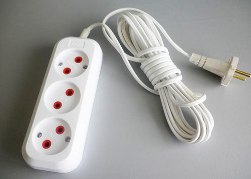 Nowadays, the number and variety of household appliances in apartments is increasing every day, but the number of outlets remains the same.
Nowadays, the number and variety of household appliances in apartments is increasing every day, but the number of outlets remains the same.
Most people living in old apartments with two or three sockets per room have to somehow get out and use tees and extension cords to connect various electrical appliances.
In this article, let's understand why it is so dangerous to use tees and extension cords?
Firstly, it is not safe. in terms of possible electric shock. The greatest danger is the use of extension cords in bathrooms. The extension cord is subject to constant physical stress, twisting. Homemade extension cords are especially dangerous in this regard ...
Which wires and cables are best used in home wiring
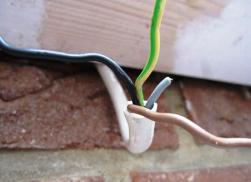 Currently, for the installation of home electrical wiring, wires and cables exclusively with copper conductors are used. Wires and cables with aluminum conductors for internal wiring not allowed.
Currently, for the installation of home electrical wiring, wires and cables exclusively with copper conductors are used. Wires and cables with aluminum conductors for internal wiring not allowed.
Wires and cables are single-core and multi-core. Stranded wires and cables have in their common sheath two or more wires that are reliably isolated from each other. An example of a stranded wire is a wire of the PRTO brand (a wire with a copper core with rubber insulation in a braid of cotton yarnsoaked with antiseptic composition).
Conductors of single-core and multicore wires and cables can be made single-wire and multi-wire. Cables and wires differ from each other by the type of sheath and names. The sheath of wires and cables serves ...
How WAGO terminal blocks are arranged
 In European countries, terminal blocks Wago are the most popular way to connect wires. We still treat them with very great suspicion, although everyone who is professionally involved in the installation of household electrical wiring knows about them. Terminals, connectors, blocks "Vaga", "Vagi" is already firmly included in the dictionary of a modern electrician.
In European countries, terminal blocks Wago are the most popular way to connect wires. We still treat them with very great suspicion, although everyone who is professionally involved in the installation of household electrical wiring knows about them. Terminals, connectors, blocks "Vaga", "Vagi" is already firmly included in the dictionary of a modern electrician.
In this article, let's understand how the terminal blocks are arranged. Wago. We will deal with the example of the most popular and universal series - WAGO 222. These terminal blocks Pare applied for connecting branches of copper single and multicore conductors in alternating current circuits with a maximum voltage of 380V and a frequency of 50 Hz. TOlemmenicki WAGO 222 can be used both for connecting lighting equipment and for installation in junction boxes ...
Wago terminal blocks in home wiring
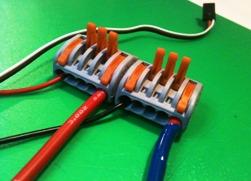 Here's a seemingly simple question: “How to connect cable cores in home wiring?” Meanwhile, when it occurs, it usually causes controversy among electricians.
Here's a seemingly simple question: “How to connect cable cores in home wiring?” Meanwhile, when it occurs, it usually causes controversy among electricians.
Simple twist? - Forbidden and unreliable. Welding wires? - It seems to be reliable, but PUE still requires certified clamps. PPE caps? - Many do not trust them, believing that they are no better than twisting with electrical tape. ZVI insulated screw clamps? - Big and not very comfortable.
It seems that if all the electricians were well acquainted with the WAGO terminal blocks, these disputes would be less. What are the advantages of these terminals, and how are they good? The main feature of the WAGO terminal blocks is that they are screwless. The design of a screwless terminal connection was developed at the German company WAGO back in 1951 ...
RCD in two-wire: to put or not to put?
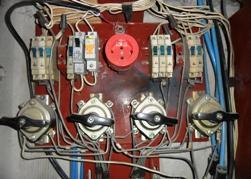 Electrical engineering is an exact science and here, unlike such ephemeral areas of human activity as, for example, design, there are clearly documented norms and rules (PUE, GOSTs, instructions), and not just “like” or “don't like”. Yes, PUE is “the bible of an electrician” and the formidable phrase “read in PUE” speaks of the importance, pumpability and great seriousness of those who said it.
Electrical engineering is an exact science and here, unlike such ephemeral areas of human activity as, for example, design, there are clearly documented norms and rules (PUE, GOSTs, instructions), and not just “like” or “don't like”. Yes, PUE is “the bible of an electrician” and the formidable phrase “read in PUE” speaks of the importance, pumpability and great seriousness of those who said it.
But it turns out in life is always much more complicated everything is arranged than it is written even in the wisest books and these books can be interpreted in different ways. Particularly heated discussions among electricians in electrical forums raise questions related to the grounding of electrical installations and the installation of residual current devices (RCDs). It so happened that in our time in everyday life there are simultaneously two grounding systems TN-C and TN-C-S ...
Protection against leakage currents: RCD and difavtomat
 According to the current rules for the installation of electrical installations, the wiring of rooms with increased danger must be equipped with protection against leakage currents. In a residential apartment, a room with increased danger is considered to be a bathroom.
According to the current rules for the installation of electrical installations, the wiring of rooms with increased danger must be equipped with protection against leakage currents. In a residential apartment, a room with increased danger is considered to be a bathroom.
Often, such a room is considered a kitchen. Both there and there may be a higher air temperature, tightness of space and high relative humidity. These factors lead to the fact that the insulation of wires and electrical equipment wears out faster, and the contact voltage increases to deadly values.
In order to eliminate this danger, protection against leakage currents is established, which is usually implemented on the basis of a residual current device (RCD) or differential circuit breaker ...
